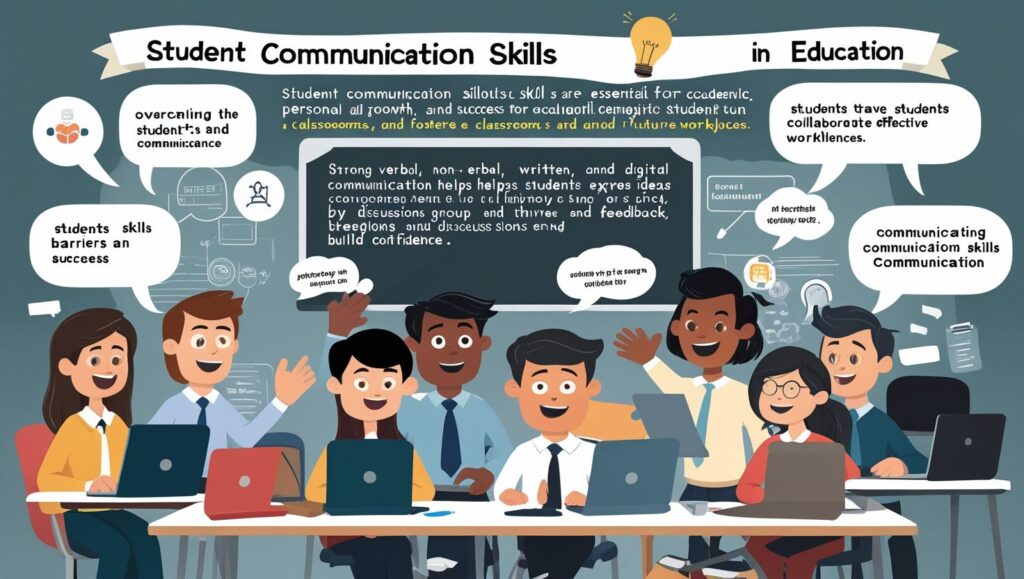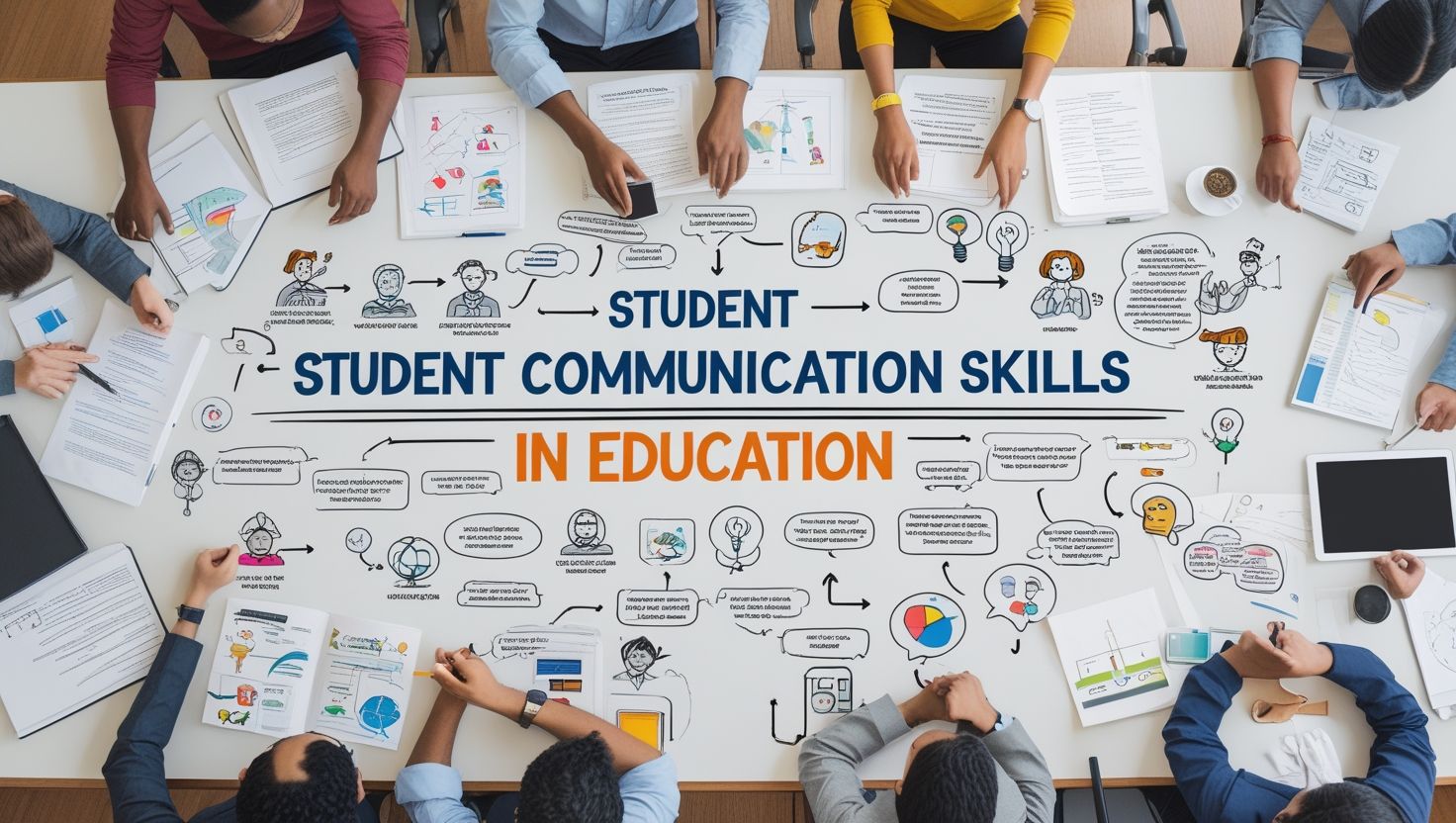Introduction
Student Communication Skills in Education, Communication skills are central to education and learning. Students who communicate effectively can express ideas, ask questions, and participate in classroom activities with confidence. Good communication also builds relationships with peers and teachers. Education today emphasizes critical thinking, collaboration, and creativity, and these goals depend on effective communication. Students must master both verbal and non-verbal skills to thrive in academic and social contexts. Moreover, communication is not only about speaking but also about listening and understanding others. Schools, therefore, should focus on developing these skills from an early stage. When students become active communicators, they learn better and engage more deeply. Furthermore, strong communication is linked with future success in careers and society. Because of this, student communication skills are widely recognized as essential. Therefore, exploring their role in education is necessary for understanding modern learning environments.
Importance of Communication Skills in Education
Communication skills help students share knowledge and learn from others. In classrooms, students who can communicate well often participate more and perform better. They are able to explain their thoughts clearly and understand instructions easily. Teachers also benefit because clear communication creates better learning outcomes. Moreover, communication builds confidence in students. They feel comfortable presenting ideas in front of classmates. In group work, these skills improve collaboration and teamwork. Employers today emphasize communication as a top skill for the workplace, making it even more important to develop in school. Additionally, communication helps in forming friendships, reducing misunderstandings, and creating a positive school climate. Without these skills, students may struggle academically and socially. Therefore, schools must highlight communication as part of overall learning. Because of this, many education systems now integrate speaking and listening exercises into curricula.
Types of Communication Skills for Students
Students use many types of communication skills in education. Verbal communication includes speaking clearly, using correct grammar, and adjusting tone for different audiences. Non-verbal communication involves gestures, facial expressions, and posture, which often convey more than words. Written communication is also critical for academic success. Students must write essays, reports, and emails effectively. Listening is another vital part because communication is not complete without understanding others. Moreover, digital communication is becoming increasingly important. Students use online platforms, social media, and learning apps to interact. Each type requires practice and awareness. For instance, eye contact during a conversation shows attentiveness. Similarly, active listening builds respect and understanding. Furthermore, written communication improves critical thinking and organization skills. Therefore, mastering all these types allows students to become well-rounded communicators. Schools must create opportunities to practice every form. As education expands into digital spaces, these skills become even more significant.

Role of Teachers in Building Communication Skills
Teachers play a vital role in shaping students’ communication skills. They model good communication through their speech, body language, and writing. Students often mirror these practices in their own behavior. Teachers also create opportunities for discussions, debates, and presentations. These activities encourage students to express themselves clearly and confidently. Additionally, teachers provide feedback that helps students improve. For example, correcting unclear sentences or suggesting better vocabulary helps students grow. Teachers can also promote listening skills by encouraging respectful dialogue. They should design group activities where students must collaborate and share ideas. Moreover, teachers need to support shy or introverted students. Encouragement builds their confidence to participate in class communication. With digital tools, teachers can also guide students on effective online communication. Therefore, the teacher’s influence is essential. When teachers prioritize communication development, students benefit academically and socially, preparing them for life beyond school.
Classroom Strategies for Enhancing Communication
Classrooms provide many opportunities to develop student communication. Group projects and collaborative activities allow students to share ideas and listen to others. Role-playing exercises help students practice real-life scenarios, such as interviews or debates. Teachers can use question-and-answer sessions to improve critical thinking and clarity. Moreover, incorporating storytelling encourages creativity and better expression. Technology also plays a role, with digital platforms offering interactive communication tools. Peer feedback sessions strengthen speaking and listening skills while building confidence. Additionally, classrooms can encourage presentations, where students learn to organize thoughts and present them clearly. Teachers should also set guidelines for respectful dialogue to create a safe environment. Furthermore, activities like mock discussions or problem-solving games make communication fun and engaging. When these strategies are applied consistently, students become more confident communicators. Therefore, classrooms that prioritize communication build stronger academic and personal development for all learners.
Barriers to Student Communication Skills
Many barriers can limit student communication skills. Language differences often create misunderstandings, especially in diverse classrooms. Shyness or lack of confidence prevents some students from speaking in front of others. Fear of judgment or making mistakes also stops participation. Additionally, limited vocabulary or poor grammar affects clarity. Non-verbal barriers, such as avoiding eye contact, can reduce effectiveness. Technology, while useful, can also create distractions and reduce face-to-face communication. Moreover, cultural differences sometimes lead to misinterpretations. For example, gestures may have different meanings in various cultures. Noise and poor classroom environments are also barriers. Teachers who do not encourage open dialogue may unintentionally limit communication growth. Furthermore, peer pressure may discourage honest expression. Overcoming these barriers requires active support from teachers and peers. Schools should build inclusive environments that support all learners. With guidance and practice, students can overcome these obstacles and improve communication.
Communication Skills and Academic Success
Communication skills are strongly linked to academic performance. Students who communicate well understand lessons more clearly. They can ask questions when concepts are unclear. This improves comprehension and learning outcomes. Strong writing skills help students perform better in essays and exams. Effective communication also improves group assignments because ideas are shared openly. Moreover, classroom participation helps students retain knowledge better. Research shows that active learners remember information more than passive listeners. Furthermore, communication skills help students access additional resources. They can ask for help from teachers or peers without hesitation. Academic success also requires presenting ideas logically, which depends on strong communication. Additionally, good listening skills help students follow instructions correctly. Without these abilities, even talented students may struggle. Therefore, improving communication directly impacts educational achievement. Schools that integrate communication into teaching methods produce higher-performing students. As a result, communication is inseparable from academic success.

Communication Skills and Career Readiness
Beyond school, communication skills prepare students for future careers. Employers consistently rank communication as one of the top skills for success. Interviews require students to express themselves confidently and clearly. Workplace tasks such as meetings, emails, and presentations depend heavily on communication. Furthermore, teamwork requires listening, sharing, and negotiating ideas. Professionals who communicate effectively often gain leadership opportunities. In contrast, poor communication can cause misunderstandings and conflicts in the workplace. Digital communication, including video calls and messaging, has also become vital. Students who learn these skills in school transition more easily into careers. Moreover, strong communication builds networks and professional relationships. It also supports problem-solving and decision-making, which employers value highly. Therefore, communication is not just an academic skill but a lifelong asset. Preparing students with these abilities ensures they are career-ready. Schools that emphasize communication create individuals who succeed in competitive job markets.
Non-Verbal Communication in Student Learning
Non-verbal communication plays a powerful role in education. Students convey much through facial expressions, gestures, and posture. For instance, nodding shows agreement or understanding. Similarly, eye contact reflects confidence and attention. Teachers also use non-verbal cues to manage classrooms. A smile encourages participation, while gestures can emphasize key points. However, students must learn to interpret these signals correctly. Misreading non-verbal communication may cause misunderstandings. Moreover, cultural differences affect body language. Schools should teach awareness of these variations to promote inclusivity. Additionally, non-verbal communication builds trust and connection. A supportive gesture or encouraging look boosts student confidence. In group activities, body language often reveals engagement or disinterest. Therefore, training in non-verbal skills enhances overall communication. Students who master these cues become more effective in both academic and social settings. Thus, non-verbal communication is as vital as spoken or written skills in education.
Digital Communication Skills in Education
In the digital age, students must master online communication. Schools now use platforms for assignments, discussions, and feedback. Students write emails, chat in groups, and attend virtual classes. Therefore, clarity in digital communication is essential. Poorly written messages may cause confusion or misunderstandings. Moreover, online etiquette, such as respectful tone and timely responses, matters greatly. Students must also learn to separate casual and formal communication. Social media adds another layer where students share ideas and collaborate. However, digital platforms also present challenges, including cyberbullying and misinformation. Schools must teach responsible online behavior and safety. Furthermore, digital communication improves access to global learning opportunities. Students can connect with peers worldwide, expanding cultural awareness. These skills are also crucial for future careers, where digital interaction dominates. Therefore, digital communication training in schools prepares students for success. As education evolves, online communication becomes increasingly central.
Conclusion
Communication skills remain at the heart of education. They enable students to participate actively, build confidence, and achieve academic success. Teachers play a guiding role by creating opportunities for practice and providing feedback. Classrooms that prioritize communication foster collaboration, respect, and inclusivity. Students also benefit by preparing for future careers, where communication is highly valued. Non-verbal and digital communication further expand the scope of these skills in modern education. Barriers exist but can be overcome with supportive teaching strategies. Schools that integrate communication development into curricula produce well-rounded learners. Ultimately, communication is not just about words but about connecting with others. As education continues to evolve, communication skills will remain essential for personal growth, academic achievement, and professional readiness. Therefore, nurturing these abilities in students ensures success in education and beyond.
References
- Hargie, O. (2016). Skilled Interpersonal Communication: Research, Theory and Practice. Routledge.
- Segrin, C., & Flora, J. (2019). Family Communication. Routledge.
- Hybels, S., & Weaver, R. L. (2017). Communicating Effectively. McGraw-Hill Education.
- Lucas, S. E. (2020). The Art of Public Speaking. McGraw-Hill Education.

Thank you for offering such practical guidance.
This topic really needed to be talked about. Thank you.
You explained it in such a relatable way. Well done!
You’re doing a fantastic job with this blog.
I appreciate the honesty and openness in your writing.
Your writing always inspires me to learn more.
I agree with your point of view and found this very insightful.
I like this web blog very much so much fantastic info .
You actually make it seem really easy with your presentation however I to find this matter to be really one thing which I believe I would never understand. It sort of feels too complex and very large for me. I am having a look forward in your subsequent put up, I will try to get the hold of it!
vteu6m
I very glad to find this site on bing, just what I was looking for : D likewise saved to bookmarks.
Insightful piece